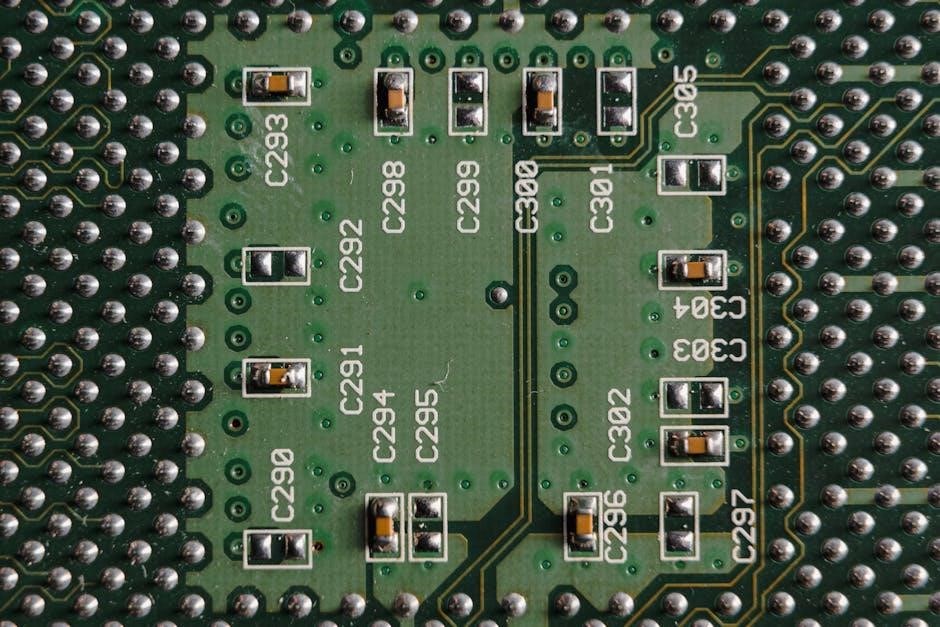
handbook for electrical engineering pdf
Electrical engineering handbooks are essential resources for understanding fundamental concepts, theoretical frameworks, and practical applications in the field. They serve as comprehensive guides for students, professionals, and researchers, covering topics from circuit analysis to power systems. These handbooks provide detailed explanations, formulas, and real-world examples, making them indispensable for both academic and professional environments.
1.1 Overview of Electrical Engineering as a Field
Electrical engineering is a dynamic and multifaceted field that encompasses the study, design, development, and application of electrical systems and technologies. It spans a wide range of disciplines, including circuit analysis, power systems, electronics, and control systems. Electrical engineers work on innovations in areas such as renewable energy, telecommunications, and automation, shaping modern infrastructure and daily life. The field requires a strong foundation in mathematics and physics, combined with practical skills in problem-solving and system design. Handbooks serve as essential resources, providing foundational theories, formulas, and best practices for both students and professionals in electrical engineering.
1.2 Importance of Handbooks in Electrical Engineering
Handbooks are indispensable resources in electrical engineering, providing a comprehensive compilation of theories, formulas, and practical applications. They serve as essential references for both educational and professional settings, offering quick access to critical information. These guides help engineers and students solve complex problems, design systems, and stay updated with industry standards. By covering a wide range of topics, from circuit analysis to power systems, handbooks ensure a deeper understanding of electrical engineering principles. They also act as valuable study aids, enabling learners to grasp key concepts efficiently. Their practical insights make them a cornerstone for professional growth and innovation in the field.

Key Topics Covered in Electrical Engineering Handbooks
Handbooks cover essential topics like circuit analysis, power systems, electronics, microcontrollers, and control systems, providing foundational knowledge and practical insights for electrical engineers and students alike.
2.1 Circuit Analysis and Design
Circuit analysis and design are fundamental topics in electrical engineering handbooks, covering the study of electrical networks to understand their behavior under various conditions. Key concepts include Ohm’s Law, Kirchhoff’s Voltage and Current Laws, and Thevenin’s Theorem. These principles enable engineers to analyze and design circuits for specific applications, ensuring efficiency and reliability. Handbooks also explore advanced topics like Laplace transforms for transient analysis and the use of circuit breakers in interrupting currents during faults. Practical examples and formulas are provided, making these resources invaluable for both students and professionals in understanding and applying circuit theory to real-world problems in power systems, electronics, and control systems.
2.2 Power Systems and Generation
Power systems and generation are crucial components of electrical engineering handbooks, focusing on the production, transmission, and distribution of electrical energy. These sections detail the principles of power generation, including thermal, hydro, wind, and renewable energy sources. Key topics include synchronous generators, power transformers, and transmission line design. Handbooks also address modern challenges such as energy efficiency, grid stability, and the integration of distributed generation systems. Practical guidance is provided on equipment selection, system optimization, and fault analysis, ensuring engineers can design and maintain reliable power systems. These resources are essential for professionals working on large-scale electrical infrastructure and sustainable energy solutions.
2.3 Electronics and Microcontrollers
Electronics and microcontrollers are foundational elements in electrical engineering handbooks, covering the design, analysis, and application of electronic circuits and systems. These sections explore nonlinear circuits, including diodes, rectifiers, and limiters, as well as advanced topics like distortion analysis and chaotic communication systems. Microcontrollers are emphasized for their role in embedded systems, with practical guidance on programming, interfacing, and real-time applications. Handbooks also delve into power electronics, optoelectronics, and signal processing, providing engineers with the tools to innovate in fields such as IoT, automation, and robotics. These resources are indispensable for designing efficient, intelligent, and adaptive electronic systems.
2.4 Control Systems and Automation
Control systems and automation are critical components in electrical engineering handbooks, focusing on the principles and applications of feedback mechanisms, stability analysis, and system optimization. These sections provide detailed insights into classical and modern control techniques, including PID controllers and state-space methods. Automation topics cover industrial control systems, programmable logic controllers (PLCs), and SCADA systems, essential for managing complex processes. Handbooks also explore emerging technologies like robotics, mechatronics, and smart control systems, emphasizing their integration with IoT and AI. These resources enable engineers to design and implement efficient, reliable, and adaptive control solutions across various industries, ensuring precision and productivity in modern automation environments.

Standard Handbooks for Electrical Engineers
Standard handbooks like The Electrical Engineering Handbook by Richard C; Dorf and the Standard Handbook for Electrical Engineers provide comprehensive coverage of electrical engineering principles, theories, and applications, serving as indispensable references for professionals and students alike. These handbooks are widely recognized for their detailed explanations, practical examples, and updates on emerging technologies, making them essential tools for both academic and professional environments. They cover a broad range of topics, from circuit analysis to power systems, ensuring a thorough understanding of the field. These resources are constantly updated to reflect the latest advancements in electrical engineering, ensuring relevance and accuracy. By including contributions from leading experts, these handbooks offer authoritative guidance on complex topics, making them invaluable for anyone seeking to deepen their knowledge of electrical engineering. Additionally, they often include sections on control systems, electronics, and automation, providing a holistic view of the discipline. Overall, these handbooks are foundational resources that support the education, research, and practice of electrical engineering worldwide.
3.1 The Electrical Engineering Handbook by Richard C. Dorf
The Electrical Engineering Handbook by Richard C. Dorf is a seminal resource widely regarded for its comprehensive coverage of electrical engineering. This third edition is meticulously structured to address both foundational concepts and advanced topics, making it accessible to students and professionals alike. The handbook delves into areas such as circuit analysis, power systems, electronics, and control systems, providing detailed explanations and practical examples. It also explores emerging fields like optoelectronics and radar technology, ensuring relevance in a rapidly evolving discipline. With contributions from leading experts, the text offers authoritative insights, supported by equations, diagrams, and real-world applications, making it an indispensable tool for understanding and advancing in electrical engineering.
3.2 Standard Handbook for Electrical Engineers
The Standard Handbook for Electrical Engineers is a cornerstone reference, offering unparalleled depth and breadth in the field. First published over 90 years ago, it remains a trusted resource for professionals and students, providing detailed coverage of electrical engineering principles and practices; The handbook spans topics such as power systems, circuit design, and control systems, with contributions from leading experts. Its practical approach, supported by equations, tables, and case studies, makes it invaluable for solving real-world problems. Regular updates ensure it reflects the latest advancements, solidifying its role as a go-to guide for electrical engineers seeking reliable, comprehensive information; Its enduring relevance underscores its importance in the field.
3.3 The Electronics Handbook
The Electronics Handbook is a definitive guide for electronics engineers, covering a wide range of topics from fundamental circuits to advanced technologies. It includes detailed sections on passive components, such as resistors and capacitors, and active devices like diodes and transistors. The handbook also delves into specialized areas like power electronics, optoelectronics, and microwaves, providing essential design and analysis techniques. With contributions from renowned experts, it offers practical insights and theoretical foundations, making it a valuable resource for both students and professionals. Regular updates ensure it stays current with emerging technologies, maintaining its status as a key reference in the field of electronics engineering.

Practical Applications of Handbook Information
Handbooks provide practical insights for designing electrical systems, troubleshooting issues, and implementing safety protocols, transforming theoretical knowledge into real-world engineering solutions and applications.
4.1 Design and Development of Electrical Systems
Handbooks are invaluable for the design and development of electrical systems, offering detailed guidance on circuit design, power distribution, and electronic systems. They provide foundational theories, practical formulas, and real-world examples, enabling engineers to create efficient and reliable electrical networks. From conceptualization to implementation, handbooks serve as a primary resource for ensuring systems meet performance, safety, and cost requirements. They also cover emerging technologies, such as renewable energy integration and smart grid solutions, making them essential for modern electrical system design and development.
4.2 Troubleshooting and Maintenance Techniques
Handbooks provide essential techniques for diagnosing and resolving electrical system issues, ensuring reliability and safety. They detail methods for identifying faults, such as short circuits or malfunctioning components, and offer step-by-step repair guidance. Maintenance strategies, including periodic inspections and testing, are emphasized to prevent equipment failure. These resources also cover safety protocols, such as proper use of circuit breakers and protective gear. By adhering to handbook guidelines, engineers can efficiently troubleshoot and maintain electrical systems, minimizing downtime and ensuring optimal performance. These practices are critical for sustaining operational efficiency and adhering to industry standards.
4.3 Safety Protocols and Standards
Electrical engineering handbooks emphasize adherence to safety protocols and industry standards to prevent accidents and ensure compliance. They outline measures such as proper insulation, grounding techniques, and the use of personal protective equipment. Handbooks also cover regulations from organizations like the National Electric Code (NEC) and the International Electrotechnical Commission (IEC). These guidelines are crucial for protecting both personnel and equipment. By following established safety standards, engineers can mitigate risks associated with electrical systems, ensuring a safe working environment and avoiding legal penalties. These protocols are continuously updated to reflect advancements in technology and best practices in the field.

Resources for Downloading Electrical Engineering Handbooks
Electrical engineering handbooks are available through various online resources, including academic websites and digital libraries. Platforms like Google Scholar, ResearchGate, and publisher sites offer free and paid PDF downloads, ensuring access to essential engineering references.
5.1 Websites Offering Free PDF Downloads
Several websites provide free PDF downloads of electrical engineering handbooks, offering convenient access to essential resources. Websites like eeeuniversity.com and preterhuman.net host free versions of “The Electrical Engineering Handbook” by Richard C. Dorf and similar texts. Additionally, platforms like ResearchGate and Academia.edu often feature user-uploaded handbooks and lecture notes. These resources are particularly valuable for students and professionals seeking affordable access to foundational knowledge. Many of these handbooks cover topics such as circuit analysis, power systems, and electronics, making them indispensable for both academic and practical applications in the field of electrical engineering.
5.2 Paid Resources and subscriptions
5.2 Paid Resources and Subscriptions
Paid resources and subscriptions offer high-quality, comprehensive electrical engineering handbooks with enhanced features and reliability. Platforms like Springer and IEEE Xplore provide access to premium handbooks, including the latest editions of “The Electrical Engineering Handbook” and “Standard Handbook for Electrical Engineers.” These resources often include interactive tools, updated content, and downloadable PDFs. Subscriptions to professional societies, such as the IEEE, also grant access to exclusive engineering materials. Paid options ensure accuracy, completeness, and adherence to industry standards, making them invaluable for professionals and researchers seeking detailed technical information.